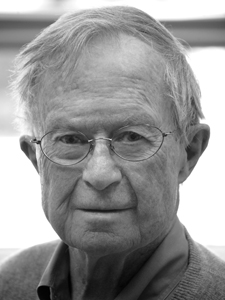
Donald P. Gaver, Jr.
Donald P. Gaver, Jr., was born on February 16, 1926 in St. Paul, Minnesota. He spent his childhood in St. Paul with his family including his sister Nancy. He attended the St. Paul Academy where he excelled in science and mathematics. He was encouraged to apply to MIT and was admitted; however, his entry was delayed as he was drafted into the U.S. Navy to serve in WW II. He received training in electronics, some of it at Monterey, California, at a base that was destined to become the Naval Postgraduate School (NPS) where he eventually returned to spend the last 48 years of his life. He spent a year on a PT boat based in Guam and became expert in radio electronics. When he returned to the U.S., he enrolled in MIT in January 1946 with the intention of pursuing a major in electrical engineering. Nevertheless, he was invited to become a math major and was especially influenced by George Wadsworth who taught probability, and specialized in a new field, now referred to as operations research. Don also took a summer course in probability from Mark Kac, who he found to be very inspiring and furthered his interest in probability. Upon completion of his undergraduate studies, he stayed to earn a masters degree in economics. There, on the advice of Paul Samuelson, he wrote his thesis under the direction of a young economist and future Nobel Prize winner, Robert Solow.
Not only did his studies at MIT shape his future professional career, by chance his sister Nancy was a student at nearby Wellesley College, and she introduced Don to her roommate, Frances Rouse. On January 24, 1953 Don and Fran were married, and they were able to celebrate their 65th wedding anniversary before Don’s passing.
After Don earned his MS degree, he joined the Operations Evaluation Group (OEG), a unit of the U.S. Defense Department in Washington DC. The period following WW II marked the birth of the field of Operations Research, and the group at OEG included Bernard Koopmans and Robert Hooke. The OEG group studied applied problems by developing mathematical and statistical models, applying appropriate techniques to solve those problems and generalizing those solutions to create policies. The OEG experience contributed greatly to Don Gaver’s lifelong talent for formulating applied problems over a wide variety of disciplines and solving those problems using sophisticated techniques in probability, statistics and applied mathematics.
In 1953, Don was urged to seek a PhD degree. Koopmans urged him to go to Columbia, while Hooke urged him to attend Princeton to work with John Tukey. Princeton won out, and he enrolled there in 1953. While he originally intended to work with John Tukey, he ended up with William Feller as his advisor, and he wrote his thesis on priority queues, finishing in 1956. He published papers on priority queueing, based on a completion time analysis, with his seminal work appearing in JRSS B in 1963.
After his Princeton graduation, he joined the mathematics department at Westinghouse Corporation in Pittsburgh, PA, headed by Robert Hooke. There he worked on a wide range of problems that arose in the various divisions of that vast corporation, most notably reliability, power systems and elevators. In 1963, he was recruited to the business school of Carnegie Mellon University (then Carnegie Tech), and in 1968 Morris DeGroot and Don Gaver co-founded the Carnegie Mellon Department of Statistics. One notable research contribution arising from a consulting project at Westinghouse was the development of an algorithm for the numerical inversion of Laplace transforms (Operations Research, 14(3), 1966, 444–459). The Gaver algorithm was accelerated by Harald Stehfest and is known today as the Gaver–Stehfest algorithm.
Don Gaver spent three years on leave in California (Stanford in 1961, Berkeley in 1967, and NPS in 1970). The lure of northern California was great, and the leave at NPS led to his moving there in 1971, remaining for the rest of his career. Don was challenged by military problems that were, and are, the focus of NPS, and he established a 40 year collaboration with Patricia Jacobs, also at NPS. He continued his wide-ranging collaborations in many areas of Statistics and OR, traveling frequently to visit collaborators, especially at Bell Laboratories, IBM and many throughout Europe.
Don Gaver’s research brought him many awards. He was a Fellow of the IMS, ASA, AAAS, INFORMS, and an elected member of the ISI. In 2009 he was awarded the U.S. Navy’s Civilian Distinguished Service Medal, their highest civilian award, and he was awarded the U.S. Army Wilks Award and the INFORMS Steinhardt medal for contributions to military operations research. Most importantly, he was elected to the U.S. National Academy of Engineering with the citation, “for contributions to reliability, maintainability and queueing concepts, with applications to telecommunications and military systems.”
Don Gaver was a brilliant scholar and educator. He was also outgoing, fun-loving, sometimes mischievous, and a joy to be around. He was a natural mentor who was always interested in and successful at helping others to succeed, especially young faculty.
Don Gaver died on February 11, 2018 and left behind his widow Fran Gaver, three children (Elizabeth, William and Donald P. III) and five grandchildren.
—
Written by John Lehoczky, Carnegie Mellon University.
John Lehoczky notes that, in addition to personal recollections, this remembrance is drawn from obituaries and profiles in: The Minneapolis Star Tribune; The Monterey Herald; The Carmel Pine Cone; and INFORMS (there is also a video interview of Donald by Patricia Jacobs on the INFORMS page).